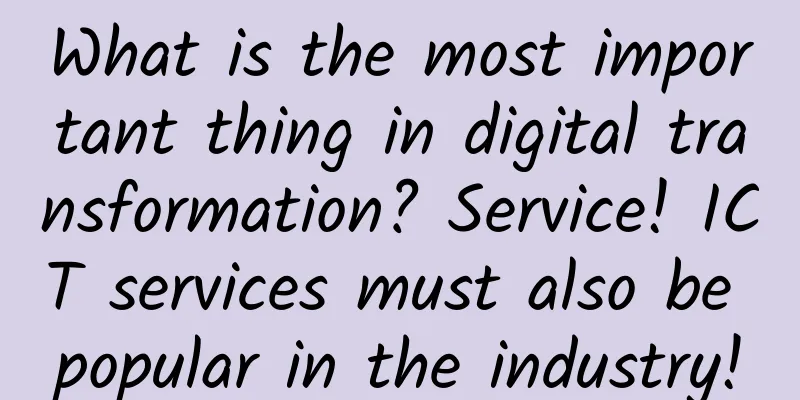Channels: Operators’ Breakthrough Skills in the 5G Era

|
An operator executive once believed that user growth among operators is more like a bowl of soup, which makes a clinking sound when it is poured over and over again. Every time it is poured over, the value of the industry decreases. Operators who have completely entered the "red ocean" are not having an easy time. Today, China has officially entered the 5G era. The "new infrastructure" headed by 5G has attracted much attention and has become the main driving force for industrial upgrading. The industry sees 5G as a major opportunity, and the three major operators are expected to spend hundreds of billions of yuan on 5G construction in 2020. But in the 5G era, can operators really easily enter the blue ocean? Operators are gradually moving towards the bottom of the value chain 2G era: fenced garden In the 2G era, telecommunications operators were the absolute "leaders" in the industry value chain. Operators used customized terminal strategies to control terminal manufacturers and had great regulatory and pricing power. In December 2000, China Mobile launched "Monternet". All content and applications were sold based on the Montenet platform, which was a veritable "fenced garden". With the popularization of mobile communications, the number of users has flourished, and the tariffs are also at a high level. The industry commented on it as follows: Montenet is undoubtedly one of the great business innovation models at the beginning of the new century. It has made an indelible contribution to saving China's Internet industry, and its development speed makes the boldest predictions seem conservative. 3G Era: Towards Pipeline In December 2008, 3G licenses were issued. At the beginning of the 3G era, the "fenced garden" of operators was torn open by Apple's new model of "terminal + application". Since then, the right to speak through customized terminal strategies to achieve upstream integration has become weaker and weaker, and the right to speak and price has been gradually weakened. Users can choose APPs at will; after the content and application are APP-based, they no longer need closed platforms such as Mobile Dream Network to carry them. The platform is becoming more and more open, and social third-party platforms are beginning to flourish and gradually become Internet giants. Operators are becoming more and more pipeline-based. Although operators also hope to use the base and professional company model to become providers of comprehensive platforms, their importance has been seriously weakened; as content applications and participants, their ability to obtain high-quality content is obviously insufficient. However, due to limited network bandwidth resources, the tariffs are still maintained at a high level, and traffic management is a hot word. 4G era: low-cost pipeline In December 2013, 4G licenses were issued. With the expansion of mobile network bandwidth, various mobile Internet platforms and applications have achieved unprecedented vigorous development. In 2014, when Taobao's "Double 11" opened, mobile transactions surpassed PC transactions, accounting for nearly 70% of the total transaction volume. Various popular applications have sprung up like mushrooms after rain. The three new "four great inventions" of shared bicycles, scanning code payment and online shopping are attributed to mobile Internet. The mobile Internet era has arrived, but operators are going further and further in the "red ocean". Users' selection criteria for terminals have become performance, photography, storage, etc. Operators have become sellers of terminal manufacturers, and their voices except for communication modules have basically been lost. With the disappearance of the demographic dividend and the increase in speed and fee reduction, especially the increase in bandwidth resources, traffic has become cheap and pipelines have begun to be devalued. As a result, the voice of one role has gradually become stronger: channel dealers. "Every time a company falls, the value of the industry decreases," but the value of channel dealers increases. So looking back over the past 20 years, telecom operators have gradually lost their roles and values, and their "strategic links" in the entire industry chain. What have operators lost in the industry chain? From the perspective of cloud, management and terminal, in the 20 years from 2G to 4G, users' demand for terminals has gradually changed from calls to application entertainment, as well as terminal performance, photography, storage, power, etc. Products and technologies themselves have become core values, and operator customization has become a thing of the past; and as users' demand for mobile Internet applications increases, Internet giants have emerged in large numbers. Therefore, the industrial value of terminal manufacturers and platform applications has increased significantly, but the situation of operators is not optimistic (as shown in Figure 1). At present, operators are facing two biggest survival pressures: First, the value of the industry continues to decline. With the implementation of policies such as speed increase and fee reduction, and the launch of various types of free traffic products, the value of operators' pipeline industry continues to decline. Traffic management has become a thing of the past, and the value of the industry has declined. Second, the control over the industrial chain has been squeezed. From upstream and downstream integration to the current lack of influence on terminals and content applications, the space for the industrial chain has been squeezed to the smallest space. Figure 1 Using the “Smile Curve” to Analyze the Changes in Operator Value With the arrival of 5G, the situation has become more complicated. From the perspective of network construction, operation and sales, the infrastructure construction in which operators participate has expanded from networks to cloud computing and edge computing on a large scale. However, due to the centralization of 5G technology, the equipment industry has become more concentrated, and the bargaining power of operators in building infrastructure has been greatly weakened, which has greatly squeezed the profit space of operators; with the disappearance of the demographic dividend, the sharp increase in channel costs is also squeezing the survival space of operators. Fortunately, the country is releasing this part of the pressure by issuing relevant policies; at the same time, due to the greatly increased demand for big data in the 5G era, more companies are participating in the industrial competition of cloud computing and edge computing, and even some equipment manufacturers have directly entered the competition in the cloud computing industry, affecting the industrial value of operators in infrastructure. Figure 2: Using the “smile curve” to look at the industry value of operators As a result, operators are squeezed by terminal vendors, content application vendors, channel vendors, and equipment vendors, and their living space is becoming increasingly narrow. With such a narrow space, will communication operators have the blue ocean they imagined when entering the 5G era? Obviously not. Without changes, operators will soon become "pipelines" again. 5G Era Where is the "blue ocean" for operators? On January 20, 2020, Miao Wei, Minister of Industry and Information Technology, said at a press conference held by the State Council Information Office that the bigger "blue ocean" of 5G is in the Internet of Things and Industrial Internet. So, where is the "blue ocean" for operators? In the era of people-to-people interconnection, the core demand of operators is to maximize the number of access terminals to maximize network efficiency, dilute fixed costs, and achieve economies of scale. After entering the 5G era of the Internet of Everything, due to the economies of scale, pursuing the scale of access terminals is still the top priority for operators. The Internet of Everything has three new characteristics.
Only when the number of terminals is large, there will be larger-scale information collection, data transmission, control command feedback, storage requirements, computing power requirements, and complex algorithm requirements. Therefore, in the 5G era, the demand for the Internet of Everything will be different for different scales of demand entities. For large enterprises, there are special needs for system stability and privacy, which are more implemented in a highly customized way; for medium-sized enterprises, they can choose to achieve flexible customization based on industry solutions for rapid replication; for the vast number of small, medium and micro enterprises, it is more appropriate to provide centralized supply in the form of platform-based and standardized products. Faced with the changes in demand in the 5G era and the pressure from terminal vendors, platform application vendors, equipment vendors and channel vendors, how can operators break through? Operators should focus on breakthroughs in the channel field Michael Porter once said that if an enterprise wants to maintain its competitive advantage, it must establish its own core competitiveness in certain strategic links of the value chain to maintain its competitive advantage. Therefore, operators must find their own core strategic value-added links in the value chain (as shown in Figure 3). (1) What if we break through on the equipment side? As analyzed in the previous article, the equipment vendor industry is already very concentrated, and the technology is becoming more complex. Operators will tend to have a symbiotic relationship with equipment vendors, promoting mutual growth, rather than seeking to squeeze value chain partners. If we break through on the content application side? In the 5G era of the Internet of Everything, the content application of the industrial Internet industry chain is closely related to the professionalism of the industry to which it belongs. For example, the industrial industry has industrial-grade standard requirements, and the aerospace industry has aerospace-grade standard requirements. At the same time, when each industry undergoes digital transformation, it is also based on its own long-term accumulation. Operators cannot be all-powerful, and they cannot conduct continuous and in-depth research in various industries. Therefore, on the content application side, they must rely on the power of the industry itself or a third party to meet the personalized needs of different industries. However, in cases where standardized products can be used for centralized supply, operators must participate in order to maximize their own industrial value. (2) How to break through on the channel side? Unlike the 4G era, since a series of needs such as data collection, transmission, storage, and computing require professional integration, system integration is a necessary role for large and medium-sized enterprises in the 5G industrial Internet era. In the future, facing the customized and semi-customized markets of large and medium-sized enterprises, system integrators will become new channel providers. In the future, facing small, medium and micro enterprises, platform providers will become an important channel provider for operators. If operators rely too much on system integrators and platform providers, they will become providers of pipeline resources for system integrators and platform providers and will soon be pipelined. Therefore, operators need to enter the field of system integration and platform construction to directly participate in the competition for the enterprise customer market. (3) What if we break through on the terminal side? Although some operators are trying to enter the field of mobile phones and VR terminals, both personal and industrial terminals require large-scale production to keep the terminal cost low enough to be competitive in the market. In addition, as analyzed in the previous article, the core advantages of current terminals are more reflected in technology, such as performance, photography, and battery life. Operators do not have valuable accumulation in these aspects, and products that rely on patchwork cannot win the market at present. However, operators can increase their influence on terminal manufacturers in terms of demand quantity by breaking through on the channel side. Figure 3 Strategic value-added links in the operator value chain Based on the above analysis, operators should focus on breakthroughs in the channel field. In the large and medium-sized enterprise market, they should focus on becoming system integrators and avoid becoming pipeline providers for system integrators. In the small, medium and micro enterprise market, they should focus on becoming providers of platforms and standardized products and avoid becoming pipeline providers for platform providers. This will expand the survival space of operators themselves in the industrial chain. At the same time, directly providing customers with solutions and platform capabilities will also greatly enhance the industrial value of operators. Only in this way can the problems of industrial value and industrial chain survival space currently faced by operators analyzed in the previous article be alleviated to a certain extent, and win the "blue ocean" in the 5G industrial Internet era. In the future, informatization and digitalization will become a necessity in life and production, and operators must have the courage to step to the forefront. |
<<: What is the value of developing smart education? 5G and AI play a key role
>>: 5G "new infrastructure", new scenarios, new models
Recommend
5G is not yet popular, but 6G patents are already the world's first, and the 6G war has already begun
5G has been promoted for a long time, but it has ...
During the COVID-19 pandemic, F5 ensures safe and stable remote work for Lancashire hospitals in the UK
Lancashire Teaching Hospitals NHS Foundation Trus...
When 5G meets new infrastructure, how will edge computing develop?
Edge computing has become one of the hottest tech...
WiFi 7 is here. What are the improvements compared to WiFi 6?
WiFi 7 has become one of the hottest topics, espe...
Gcore (gcorelabs) Santa Clara VPS simple test
A few days ago, we posted simple test information...
Enterprise 5G: A guide to planning, architecture and benefits
Enterprise 5G deployments require extensive plann...
Interviewer: What are the ways of communication between components in React?
[[409233]] This article is reprinted from the WeC...
Gcore: KVM host from €1.08/month, 26 data centers available in Russia/Asia Pacific/Europe and America
G-core (gcorelabs) is a foreign hosting company f...
What are the popular LAN technologies and LAN types today?
LAN technology in computer networking is widely u...
HostKvm New Year Promotion: 40% off Australian VPS/20% off all products, 2G memory package starting from $4.2/month
HostKvm has launched a special promotion during t...
PwC: By 2030, 5G will contribute $1.3 trillion to global GDP growth
On February 10, foreign media reported that a rep...
What is the transport layer protocol?
Transport layer protocols are an important part o...
China Broadcasting Corporation's 5G 700MHz construction encounters a song of "ice and fire"
Recently, China Radio and Television Network Co.,...
CloudCone promotional annual payment of $9.99 VPS restock, Los Angeles MC data center
CloudCone has added more inventory to the Hashtag...
MWC19 Shanghai | Ruijie Networks invites you to gather together to see the cutting-edge and talk about the future
[[268236]] June 26-28 Asia's technology indus...









